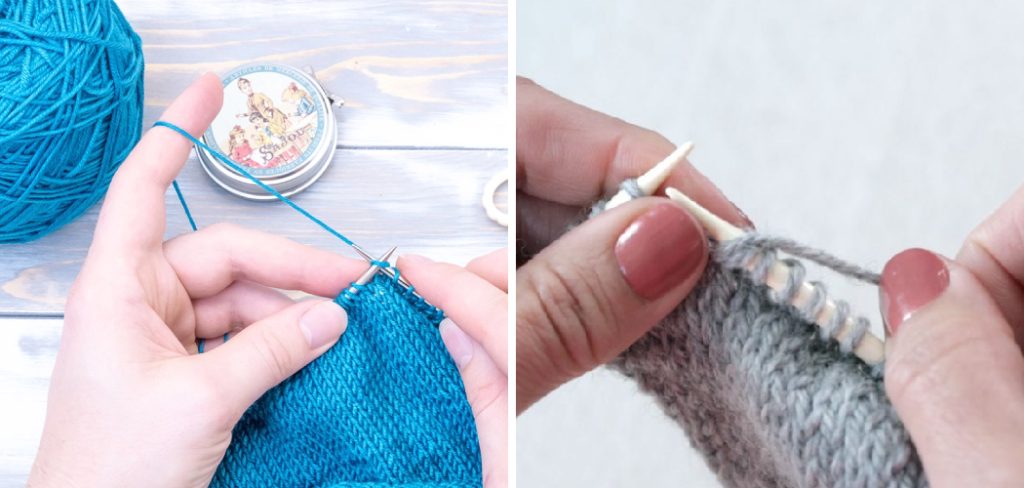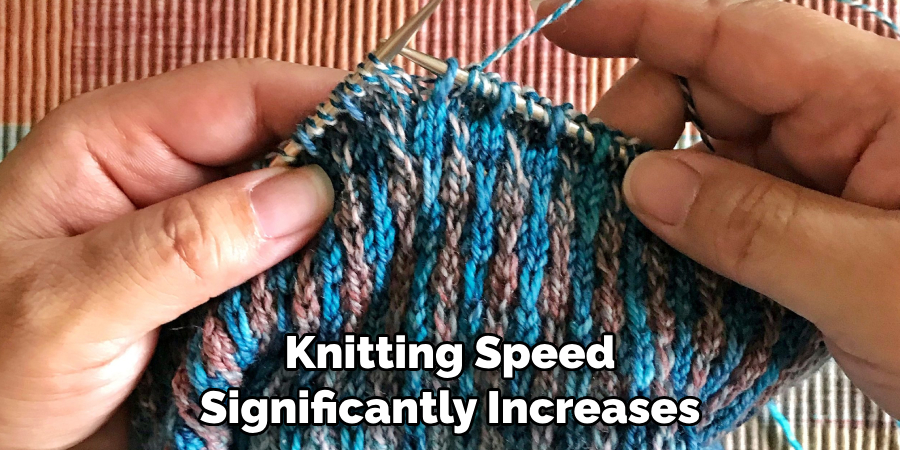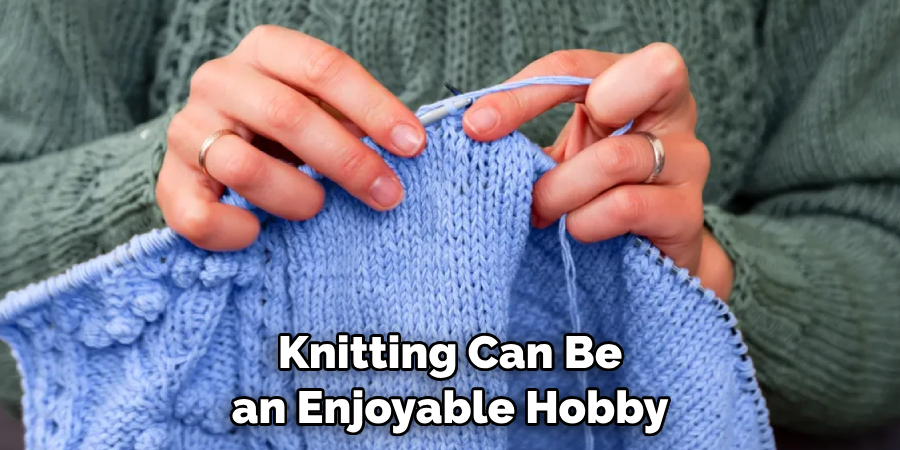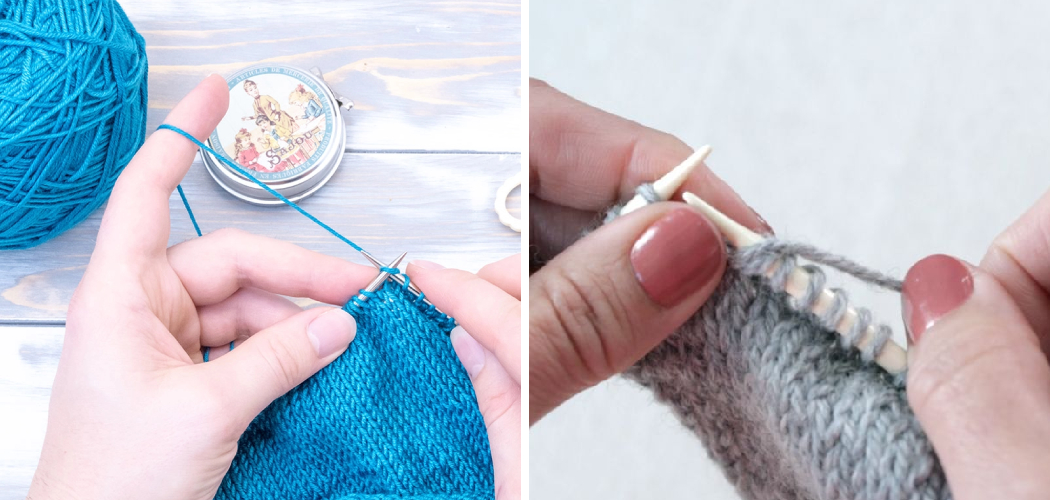Ready to get your knit on? Knitting can be a great way to relax and create something beautiful—but if you want a quick project, it’s important to understand some of the basics for knitting quickly.
We’ll teach you how easy it is to speed up your knitting so that you can finish quicker and take pride in your creations! You don’t have to sacrifice detailed patterns or complex stitches either – with our simple tips, you’ll soon become an expert knitter who whips up pieces in no time.

Whether you’re a novice knitter or an experienced crafter, here are our top tips for how to knit fast. Just a few of these tricks can significantly reduce your knitting time. Let’s jump right in!
What Will You Need?
To get started, you’ll need a few basic materials:
- Yarn: Choose your yarn carefully and ensure it suits your project. Opt for lighter colors and thinner weights to finish faster.
- Needles: Use the longest needles possible to help speed up your knitting by allowing you to fit more stitches on each row.
- Scissors: For cutting yarn at the end of a project.
Once you have your materials, let’s move on to the next step!
10 Easy Steps on How to Knit Fast
Step 1. Choose Your Pattern Wisely
Choose a pattern with few stitches and easy-to-follow instructions. This will make your knitting easier to understand and save you time in the long run. Choose a pattern with wide columns—this will help make your knitting faster and more uniform.
Step 2. Use Stitch Markers
Stitch markers are essential for any project, as they help track where you are in the pattern. This is especially true when working on complex patterns that require frequent stitch counting. Try to use stitch markers for every row and column to maximize accuracy and speed.
Step 3. Use the Right Needles
Using longer needles will make it much easier to fit more stitches on each row, allowing you to work faster. Additionally, circular needles are great for knitting in the round since they don’t require any turning. If you’re knitting a flat piece, try using straight needles that are long enough to fit the whole row.

Step 4. Take Breaks
Taking regular breaks will help keep your concentration levels high and ensure your work stays accurate. We recommend taking a break for 10-15 minutes after each hour of knitting—this will give you time to stretch and move around before getting back to your project. Be careful not to overwork yourself and stay hydrated!
Step 5. Use a Cable Needle
Cable needles are small tools that help you knit more complex patterns by allowing you to easily transfer stitches from one needle to another while keeping the tension correct. This is especially helpful when working with cables, as it helps keep the pattern consistent and even. Remember to leave the cable needle in place until you finish the row.
Step 6. Learn How to Make a Longer Tail
When beginning your project, leave a long tail of yarn. Doing this will save you time and help make your work look more polished. To create a longer tail, knit with both ends of the yarn and tie them together at the end of your project.
Step 7. Use a Larger Hook
Utilizing a larger hook is another effective method to speed up your knitting process. The larger the hook, the bigger the stitches and fewer you have to make, which subsequently means fewer rows to get to the length you want. This can significantly cut down on your knitting time.
However, be mindful of your pattern’s recommendations, as using a too large hook can make the finished project appear loose or lacy. Always make sure to do a small test swatch with your chosen yarn and hook to ensure the resulting fabric meets your expectations before you dive into the full project.
Step 8. Master the Continental Knitting Technique
One of the keys to knitting fast is mastering the continental knitting technique. This method, often called ‘picking,’ involves holding the yarn in your left hand and picking it with the right needle.
Many knitters find this method faster than traditional English (‘throwing’) because it requires less movement, allowing you to maintain a steady, quick rhythm. Practice this technique until you’re comfortable with it and your knitting speed significantly increases.

Step 9. Practice, Practice, Practice
There is no shortcut to becoming a fast knitter other than practice. The more you knit, the more natural the movements will become, allowing you to knit without thinking about each stitch.
Start with simple patterns and gradually move on to more complex ones as you grow more comfortable. Speed will come with time and practice, so don’t rush yourself. Consistent practice will improve not only your speed but also your technique and overall knitting skills.
Step 10. Stay Organized
Lastly, staying organized can significantly improve your knitting speed. Keep your yarn, needles, and other materials neatly organized and within reach. This will save you time searching for your supplies. Also, try to keep your workspace clutter-free. A clean and organized workspace allows for a clear mind, enhancing focus and productivity.
By following these steps and incorporating them into your knitting routine, you’ll knit faster in no time. With a few simple adjustments, you can make the most of your crafting sessions and easily create beautiful pieces.
5 Additional Tips and Tricks
- Use the Right Tools: Investing in high-quality knitting needles and yarn can also significantly improve your knitting speed. Smooth needles allow for faster movements, while a well-spun yarn can help prevent tangles and snags.
- Learn Continental Knitting: Also known as ‘picking,’ continental knitting is often considered faster than the traditional ‘throwing’ method. This style involves holding your yarn in your left hand, which can help streamline your movements and increase your knitting speed.
- Maintain Good Posture: Good posture can help reduce fatigue and allow for more efficient movements. Try to keep your back straight, and your shoulders relaxed while knitting. Knit in a comfortable chair that supports your back and arms.
- Minimize Unnecessary Movements: Try to keep your hand and finger movements to a minimum. The more efficient your movements, the faster you can knit. Watch experienced knitters and try to replicate their techniques to speed up your knitting.
- Try a Larger Needle Gauge: Knitting with larger-gauge needles can help you knit faster, as they create larger stitches. The downside is that the fabric produced will be more open and less dense, so choose your needles carefully.

By following these tips, you’ll be able to improve your knitting speed and efficiency dramatically.
5 Things You Should Avoid
- Avoid Too Tight Stitches: One common mistake that can slow down your knitting speed is making your stitches too tight. Tight stitches make inserting your needle into the loops harder, slowing down your knitting process. It can also lead to hand and wrist strain. Practice maintaining consistent, moderate tension in your yarn to avoid this issue.
- Don’t Rush: While it’s natural to want to knit faster, trying to rush can lead to mistakes and dropped stitches, which will ultimately slow you down. Take your time and focus on consistency and accuracy over speed. As you become more experienced, speed will naturally follow.
- Avoid Distractions: It may seem counterintuitive, but multitasking can slow you down. Avoid distractions such as television or complex conversations while knitting. This lets you concentrate fully on your work, resulting in faster and higher-quality knitting.
- Don’t Neglect Practice: Knitting speed comes with practice. Stay calm if you see immediate improvements in your speed. Just keep practicing consistently, and your speed will gradually increase.
- Don’t Use Uncomfortable Needles: Uncomfortable needles can slow you down and make knitting less enjoyable. Always choose comfortable needles in your hands and suit the yarn and stitch you’re working with.
By avoiding these common pitfalls, you can enhance your knitting speed, making your sessions more productive and enjoyable.
Is It Bad to Knit for Too Long?
Yes, it’s possible to overdo it when it comes to knitting. Take regular breaks throughout the day and stretch before and after each session for your safety and health. This will help prevent strain or soreness in your hands, wrists, and arms.
Additionally, if you’re knitting for too long, you may need to give your eyes and mind a break, leading to fatigue. If you feel any pain or discomfort, take a break immediately and rest for at least 10 minutes before continuing. As with any activity, balance is key – don’t overdo it!
Knitting can be an enjoyable hobby as long as you take proper precautions. With some practice and patience, you can knit faster while avoiding any potential risks. So go ahead and enjoy your knitting sessions – now that you know how to knit fast, you can create even more beautiful pieces!

Conclusion
After taking the time to go through all of the tips we have identified, you should now have a better understanding of how to knit faster and more efficiently. Challenging yourself with different projects is also helpful when you improve your knitting speed. If you haven’t already, why not give it a try? Ensure you anchor each stitch and be mindful of how you hold your needles.
Having an organized workspace will also help keep your technique consistent. The goal is to start with simple items and then increase the complexity as your speed improves.
Remember to practice, practice, practice—you can get faster at knitting if you stick with it! Finally, don’t forget how rewarding knitting can be—be proud when completing that project in record time!

